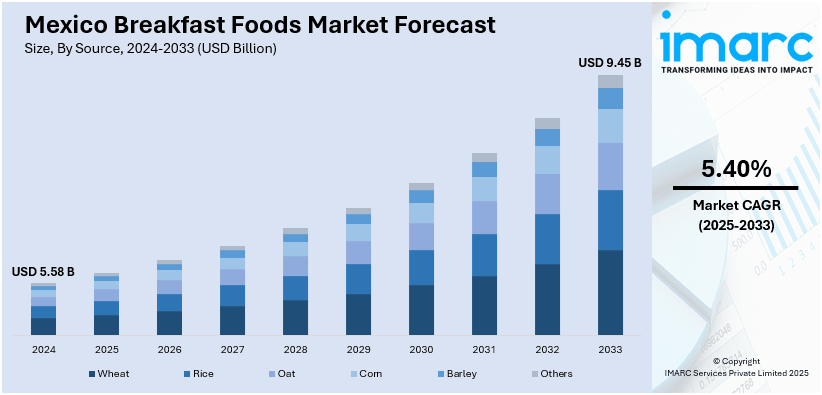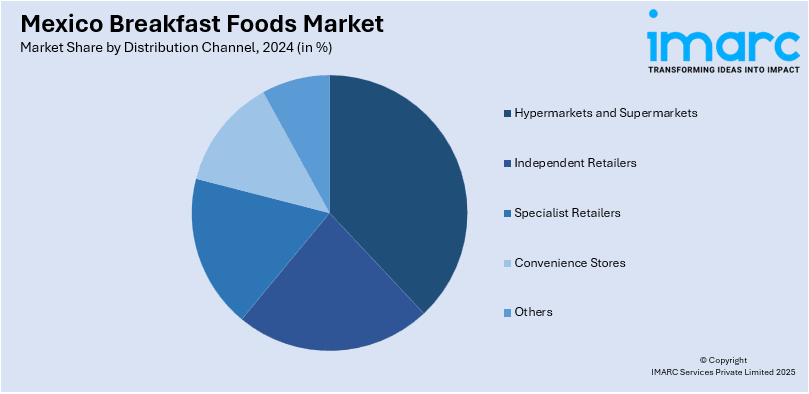
Mexico Breakfast Foods Market Size, Share, Trends and Forecast by Source, Packaging Type, Distribution Channel, and Region, 2025-2033
Mexico Breakfast Foods Market Overview:
The Mexico breakfast foods market size reached USD 5.58 Billion in 2024. Looking forward, IMARC Group expects the market to reach USD 9.45 Billion by 2033, exhibiting a growth rate (CAGR) of 5.40% during 2025-2033. In Mexico, the growing health consciousness is catalyzing the demand for nutritious, functional breakfast options, with consumers looking for high-protein, fiber-rich foods. Digital marketing and food influencers are shaping consumer preferences, particularly for plant-based and low-sugar products, as social media platforms play a key role in trend development, further influencing the Mexico breakfast foods market share.
|
Report Attribute
|
Key Statistics
|
|---|---|
|
Base Year
|
2024
|
|
Forecast Years
|
2025-2033
|
|
Historical Years
|
2019-2024
|
| Market Size in 2024 | USD 5.58 Billion |
| Market Forecast in 2033 | USD 9.45 Billion |
| Market Growth Rate 2025-2033 | 5.40% |
Mexico Breakfast Foods Market Analysis:
- Market Drivers: Increasing health consciousness is promoting demand for healthy breakfast foods, such as high-fiber and vegetarian foods. Busy life and urbanization are pushing demand for ready-to-eat (RTE) and easy-to-consume food. Furthermore, increasing disposable incomes enable consumers to try premium products, giving rise to a market scenario stressing quality, diversity, and accessibility thus aiding the Mexico breakfast foods market demand.
- Key Market Trends: Increasingly, consumers prefer natural ingredient, healthier, and functional breakfast foods. Convenience is paramount, with single-serve and portable packaging becoming more popular. Brands embrace sustainable packaging and transparent labeling and use innovative flavors and formats. Digital marketing and social media drive purchasing decisions, so personalization and experiential consumption are at the heart of trends today.
- Market Challenges: Shifting consumer behavior challenges conventional breakfast foods. Competition from home-cooked or culturally acceptable meals can restrict market penetration. Increased ingredient prices and supply chain volatility affect manufacturing. Satisfying various dietary requirements, retaining taste and affordability, is challenging. Brands need to innovate on a consistent basis while navigating health, convenience, and cultural sensibilities.
- Market Opportunities: Based on the Mexico breakfast foods market analysis, expanding health-oriented, organic, and functional breakfast foods. Joining forces with local vendors can make distribution stronger. Online platforms provide channels for consumer interaction and brand education. Inventing new flavors, textures, and convenient packaging can bring new segments. Sustainability campaigns and storytelling build loyalty and make brands stand out in a crowded market.
Mexico Breakfast Foods Market Trends:
Increasing Health Consciousness Among Consumers
With the rising number of individuals embracing balanced eating habits and emphasizing healthy living, the need for nutritious and functional breakfast choices is supporting the Mexico breakfast foods market outlook. Consumers are progressively looking for breakfast options that not only satisfy hunger but also support their broader health and wellness objectives. Products high in protein, fiber, and vitamins, like granola, low-sugar cereals, plant-based milks, and fortified juices, are becoming increasingly favored for their tastes combined with health advantages. The rise of health-focused millennials and Gen Z consumers is encouraging brands to create new products that address specific dietary preferences, such as gluten-free, organic, and low-carb alternatives. This transition to healthier breakfast options is transforming the product scene, with brands concentrating on providing a wider range of customized solutions. The increasing emphasis on health is apparent in Mexico's extensive wellness sector, which achieved USD 52.3 billion in 2024 and is expected to rise to USD 80.9 billion by 2033, showing a CAGR of 4.58% from 2025 to 2033, as reported by IMARC Group. This expansion emphasizes the rising significance of health and wellness in consumer choices, encouraging brands to adapt with offerings that satisfy the changing need for healthier, more functional breakfast options.

To get more information on this market, Request Sample
Influence of Digital Marketing and Food Influencers
Digital marketing and social media influencers are progressively impacting the buying choices of consumers, especially in the breakfast foods sector. Food influencers dominate social media platforms, showcasing the latest breakfast trends, recipes, and product reviews, influencing the preferences of their audience. The eye-catching essence of breakfast items, such as colorful smoothie bowls, nutritious breakfast tacos, and elaborately arranged brunch platters, aligns seamlessly with the format of these platforms, making them ideal for culinary content. Food influencers serve a dual purpose by both endorsing certain brands and informing their followers about new health trends, the nutritional advantages of different products, and recent product releases. This trend is leading to a growing popularity for breakfast items that match consumer preferences for plant-based, low-sugar, and high-protein choices. In addition, digital marketing strategies aimed at younger, technology-minded consumers are catalyzing the demand for creative breakfast products. The increasing impact of social media is clear in Mexico, where DataReportal indicated there were 90.20 million users in January 2024, representing 70.0% of the overall population. This substantial and active audience persists in shaping the Mexico breakfast foods market growth, as influencers establish trends that appeal to the health-oriented, trend-aware crowd, encouraging both major and new brands to utilize these digital channels to promote their products successfully.
Mexico Breakfast Foods Market Segmentation:
IMARC Group provides an analysis of the key trends in each segment of the market, along with forecasts at the country and regional levels for 2025-2033. Our report has categorized the market based on source, packaging type, and distribution channel.
Source Insights:
- Wheat
- Rice
- Oat
- Corn
- Barley
- Others
The report has provided a detailed breakup and analysis of the market based on the source. This includes wheat, rice, oat, corn, barley, and others.
Packaging Type Insights:
- Boxes
- Pouches
- Others
The report has provided a detailed breakup and analysis of the market based on the packaging type. This includes boxes, pouches, and others.
Distribution Channel Insights:

- Hypermarkets and Supermarkets
- Independent Retailers
- Specialist Retailers
- Convenience Stores
- Others
A detailed breakup and analysis of the market based on the distribution channel have also been provided in the report. This includes hypermarkets and supermarkets, independent retailers, specialist retailers, convenience stores, and others.
Regional Insights:
- Northern Mexico
- Central Mexico
- Southern Mexico
- Others
The report has also provided a comprehensive analysis of all the major regional markets, which include Northern Mexico, Central Mexico, Southern Mexico, and others.
Competitive Landscape:
The market research report has also provided a comprehensive analysis of the competitive landscape. Competitive analysis such as market structure, key player positioning, top winning strategies, competitive dashboard, and company evaluation quadrant has been covered in the report. Also, detailed profiles of all major companies have been provided.
Latest News and Developments:
- In August 2025, McCormick & Co. is acquiring an additional 25% of McCormick de Mexico from Grupo Herdez for $750 million, increasing its ownership to 75%. The move strengthens McCormick’s presence in the Mexican market and provides a strategic platform for Latin American expansion. McCormick de Mexico generates around $810 million in annual sales, with growth expected in the mid-single digits.
- In June 2025, C.H. Guenther & Son LLC purchased Fresca Mexican Foods LLC thereby enhancing its tortilla production and foodservice partnerships. Fresca is close to Boise, Idaho and operates a 190,000-sq.-ft. facility in Caldwell, Idaho, with 375 employees producing flour tortillas, corn tortillas and tortilla chips, and has long-standing relationships with many foodservice companies. This acquisition is an opportunity for Guenther to enhance its capacity, expand the portfolio and strengthen relationships with fast-casual restaurant chains and quick-service restaurant (QSR) chains. Guenther is owned by Pritzker Private Capital and has approximately 5,000 employees and 30 locations worldwide.
Mexico Breakfast Foods Market Report Coverage:
| Report Features | Details |
|---|---|
| Base Year of the Analysis | 2024 |
| Historical Period | 2019-2024 |
| Forecast Period | 2025-2033 |
| Units | Billion USD |
| Scope of the Report |
Exploration of Historical Trends and Market Outlook, Industry Catalysts and Challenges, Segment-Wise Historical and Future Market Assessment:
|
| Sources Covered | Wheat, Rice, Oat, Corn, Barley, Others |
| Packaging Types Covered | Boxes, Pouches, Others |
| Distribution Channels Covered | Hypermarkets and Supermarkets, Independent Retailers, Specialist Retailers, Convenience Stores, Others |
| Regions Covered | Northern Mexico, Central Mexico, Southern Mexico, Others |
| Customization Scope | 10% Free Customization |
| Post-Sale Analyst Support | 10-12 Weeks |
| Delivery Format | PDF and Excel through Email (We can also provide the editable version of the report in PPT/Word format on special request) |
Key Benefits for Stakeholders:
- IMARC’s industry report offers a comprehensive quantitative analysis of various market segments, historical and current market trends, market forecasts, and dynamics of the Mexico breakfast foods market from 2019-2033.
- The research report provides the latest information on the market drivers, challenges, and opportunities in the Mexico breakfast foods market.
- Porter's five forces analysis assist stakeholders in assessing the impact of new entrants, competitive rivalry, supplier power, buyer power, and the threat of substitution. It helps stakeholders to analyze the level of competition within the Mexico breakfast foods industry and its attractiveness.
- Competitive landscape allows stakeholders to understand their competitive environment and provides an insight into the current positions of key players in the market.
Key Questions Answered in This Report
The breakfast foods market in Mexico was valued at USD 5.58 Billion in 2024.
The Mexico breakfast foods market is projected to exhibit a CAGR of 5.40% during 2025-2033, reaching a value of USD 9.45 Billion by 2033.
Key factors driving Mexico’s breakfast foods market include rising health consciousness, increasing demand for convenient on-the-go meals, and urbanization influencing busy lifestyles. Growing disposable incomes encourage exploration of premium products, while evolving consumer preferences for nutritious, diverse, and culturally adapted options push brands to innovate, creating sustained market growth.
Need more help?
- Speak to our experienced analysts for insights on the current market scenarios.
- Include additional segments and countries to customize the report as per your requirement.
- Gain an unparalleled competitive advantage in your domain by understanding how to utilize the report and positively impacting your operations and revenue.
- For further assistance, please connect with our analysts.
 Request Customization
Request Customization
 Speak to an Analyst
Speak to an Analyst
 Request Brochure
Request Brochure
 Inquire Before Buying
Inquire Before Buying




.webp)




.webp)












